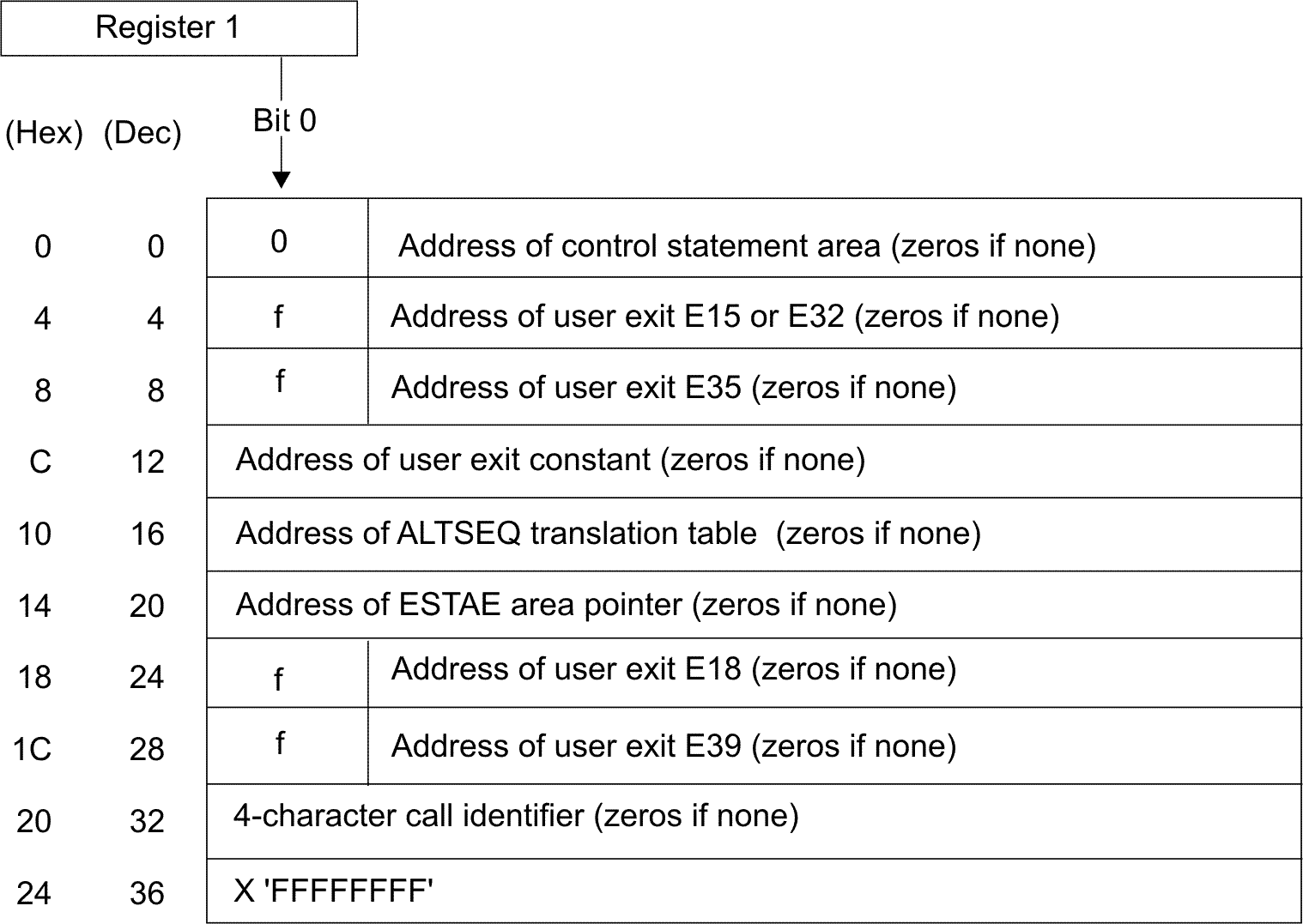Figure 1 shows the format of the
extended parameter list and the pointer, which you must pass to DFSORT,
containing its address.
The first parameter must be specified. A 4-byte field containing X'FFFFFFFF' must be
used to indicate the end of the parameter list. It can be coded anywhere
after the first parameter.
If a parameter is specified, it must appear in the indicated position
and must contain a 31-bit address or a clean (the first 8 bits containing
zeros) 24-bit address. If a parameter is not specified, it is treated
as if it were specified as zeros. For full override and applicability
details, see Specification/override of DFSORT options.
Figure 1. The Extended
Parameter List
Detailed specifications for each of the entries in the parameter
list follow:
- Byte
- Explanation
- 0-3
- Required. The address of the area containing the DFSORT control
statements, if any; otherwise, all zeros. The high order bit must
be 0 to identify this as an extended parameter list.
Refer to the
previous section for the format of the control statement area.
Attention: The area
must start with a two-byte length field.
If you specify this
parameter as zeros, you must supply all the required control statements
in DFSPARM or SORTCNTL.
- 4-7
- Optional. The address of the E15 or E32 user exit routine that
your program has placed in main storage (for example, via LOAD), if
any; otherwise, all zeros.
f (bit 0) has the following meaning:
- 0 = Enter the user exit with 24-bit addressing in effect (AMODE
24).
- 1 = Enter the user exit with 31-bit addressing in effect (AMODE
31).
Note: If the
Blockset or Peerage/Vale technique is not selected, the user exit
is always entered with 24-bit addressing in effect (AMODE 24).
- 8-11
- Optional. The address of the E35 user exit routine that your program
has placed in main storage (for example, via LOAD), if any; otherwise,
all zeros.
f (bit 0) has the following meaning:
- 0 = Enter the user exit with 24-bit addressing in effect (AMODE
24).
- 1 = Enter the user exit with 31-bit addressing in effect (AMODE
31).
Note: If the Blockset or Peerage/Vale technique is not
selected, the user exit is always entered with 24-bit addressing in
effect (AMODE 24).
- 12-15
- Optional. This field will be passed to the E15, E32 or E35 user
exit routines.
Note: The user exit address constant must not be used
for a Conventional merge or tape work data set sort application.
- 16-19
- Optional. The address of a 256-byte ALTSEQ translation table supplied
instead of an ALTSEQ statement, if any; otherwise, all zeros. You
can use this option to override an ALTSEQ installation
option. For full override and applicability details, see Specification/override of DFSORT options.
- 20-23
- Optional. The address of a 4-byte field containing the address
of a 112-byte work area where ESTAE information is saved, or all zeros
if the ESTAE information is not saved.
If a system or user exit
abend occurs, the DFSORT recovery routine will copy the first 112
bytes of the software diagnostic work area (SDWA) into this area before
returning to your ESTAE recovery routine.
- 24-27
- Optional. The address of the E18 user exit routine that your program
has placed in main storage (for example, via LOAD), if any; otherwise,
all zeros.
Note: This parameter is ignored for a merge application
and for a tape work data set sort application.
f (bit 0)
has the following meaning:
- 0 = Enter the user exit with 24-bit addressing in effect (AMODE
24).
- 1 = Enter the user exit with 31-bit addressing in effect (AMODE
31).
Note: If the Blockset or Peerage/Vale technique is not
selected, the user exit is always entered with 24-bit addressing in
effect (AMODE 24).
- 28-31
- Optional. The address of the E39 user exit routine that your program
has placed in main storage (for example, via LOAD), if any; otherwise,
all zeros.
Note: This parameter is ignored for a conventional merge
application and for a tape work data set sort application.
f
(bit 0) has the following meaning:
- 0 = Enter the user exit with 24-bit addressing in effect (AMODE
24).
- 1 = Enter the user exit with 31-bit addressing in effect (AMODE
31).
Note: If the Blockset or Peerage/Vale technique is not
selected, the user exit is always entered with 24-bit addressing if
effect (AMODE 24).
- 32-35
- Optional. 4 characters to be used as an identifier for this call
to DFSORT. This field can be used to uniquely identify each call
to DFSORT from a program that calls DFSORT more than once. DFSORT
prints message ICE200I to display the field identifier exactly as
you specify it; the field is not checked for valid characters.
If
the field identifier is specified, it must appear in the indicated
position. If the identifier field contains zeros (X'00000000'),
or X'FFFFFFFF' is used to end the parameter list before or
at the field identifier, DFSORT does not print message ICE200I.
Note: The list can be ended after any parameter. The
last parameter in the list must be followed by X'FFFFFFFF'.
 z/OS DFSORT Application Programming Guide
z/OS DFSORT Application Programming Guide
 z/OS DFSORT Application Programming Guide
z/OS DFSORT Application Programming Guide




 Copyright IBM Corporation 1990, 2014
Copyright IBM Corporation 1990, 2014